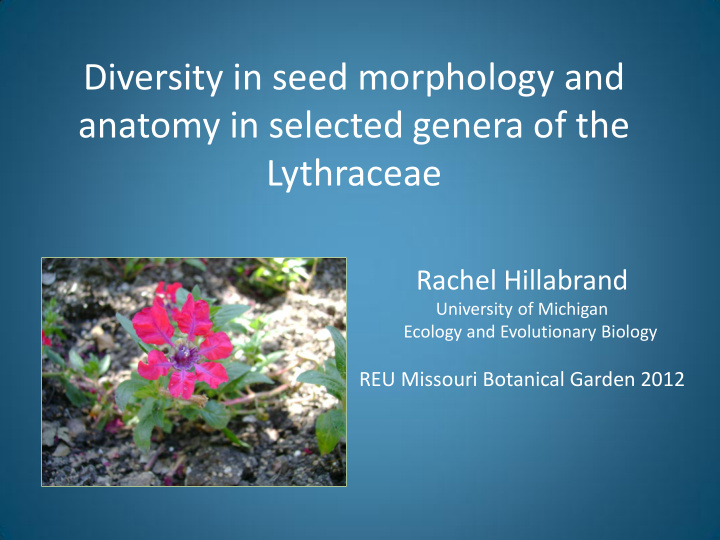



Diversity in seed morphology and anatomy in selected genera of the Lythraceae Rachel Hillabrand University of Michigan Ecology and Evolutionary Biology REU Missouri Botanical Garden 2012
Introduction • Lythraceae is a globally distributed family • Occupies a range of habitats including woodland, mangrove, and aquatic • Lythraceae seeds have a diverse morphology and a large range in size Mackeith, 1978 Galpinia Ammannia Ginoria Lafoensia
Introduction The seed coat is comprised of an outer integument called the testa and an inner integument called the tegmen. The Lythraceae are known to have a seed coat with a well- developed, multi-layered testa. Exo-testa (epidermis) Meso-testa Endo-testa Tegmen Lythrum
Objective • This study used light microscopy and scanning electron microscopy to observe and describe seed characters in selected genera of the Lythraceae. Ginoria Galpinia Lythrum
Methods • Seeds were soaked in 4% ethylenediamine overnight to soften the tissue • The paraffin blocks were sliced with a rotary microtome at 10 μ m • Specimens were mounted and stained with touludine blue • Seeds observed with SEM were broken or cut with a razor blade
Results & Discussion
Genera • Lythrum • Didiplis • Heimia • Pleurophora • Pehria • Galpinia • Cuphea • Ginoria • Ammannia • Lagerstroemia • Lafoensia * * SEM only
Wings • Diversity in wing morphology within the family • Light, thin-walled cells imply wind dispersal Galpinia Lagerstroemia Lafoensia
Spiral epidermal trichomes Found in epidermal layer Spiral shaped in Cuphea, Pleurophora , Lafoensia Seeds are more easily fixed to the soil Pleurophora Cuphea
Straight epidermal trichomes • Found in epidermal layer • Ammannia, Ginoria, Pehria, Heimia, Didiplis, Lythrum Ammannia
Epidermal layer Assist in dispersal in aquatic environments Float Cells - Ammannia
Summary of Seed Characters Table 1. Seed characters of selected genera of Lythraceae Spiral Straight Aerenchyma Crystals Taxon Size L,W (mm) Outline Wings epidermal epidermal float cells present trichomes trichomes Lythrum californicum 0.4, 0.3 obovate - - + - + Didiplis diandra 0.7, 0.3 oblong - - + - + Heimia apetala 0.6, 0.4 obtriangular - - + - + Pleurophora saccocarpa 0.8, 0.5 obovate - + - - + Pehria compacta 0.6, 0.3 obong - - + - + Galpinia transvalica 3.0, 3.0 sub-orbicular + - - - - Cuphea confertiflora 2.0, 2.0 orbicular - + - - + Ginoria midiflora 1.8, 0.4 oblong - - + - - Ammannia coccines 0.3, 0.3 obovate - - + + + Lagerstroemia indica cultivated 7.0, 4.0 obtriangular + - - - - Lafoensia vandelliana 19.0, 10.0 oblong + + - - +
Conclusion • The diversity in seed characters supports a variety of dispersal mechanisms suited for a range of habitats. • The variety of characters that enhance dispersal have allowed Lythraceae to occupy habitats across the globe.
Acknowledgements • Dr. Shirley Graham – mentor • Dr. David Bogler – REU coordinator + lab techniques • Dr. Sandra Arango-Caro – REU coordinator • Dr. Richard Keating – microtechnique • Missouri Botanical Garden • National Science Foundation
References Carlquist, S. 1982. The use of Ethylenediamine in softening hard plant structures for paraffin sectioning. Biotechnic and Histochemistry 57: 311-317 Corner, E. J. H. 1976. The seeds of dicotyledons. Vol. 1, 2. Cambridge Univ. Press, Cambridge. Graham, S. A. 2007. Lythraceae. In K. Kubitzki (Ed.), The families and genera of vascular plants, Vol. 9. K. Kubitzki (Ed.), Eudicots (pp. 226 – 246). Berlin/Heidelberg/New York: Springer Grubert, Meinhard. 1974. Studies on the distribution of myxospermy among seeds and fruits of angiospermae and its ecological importance. Acta Biological Venezuelica . 8: 315-550 . Stubbs JM, AR Slabas. 1982. Ultrastructural and biochemical characterization of the epidermal hairs of the seeds of Cuphea procumbens . Planta 155: 392-399
Recommend
More recommend